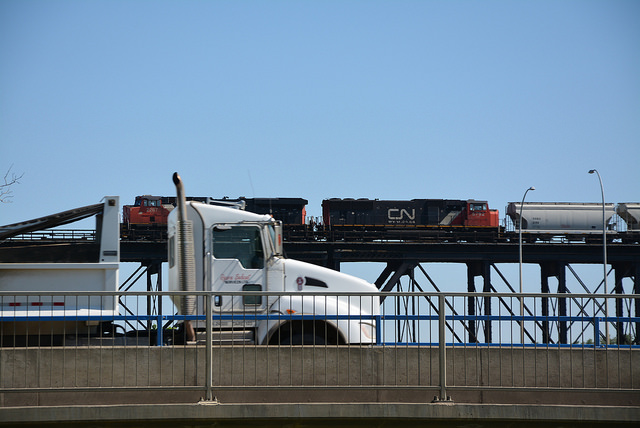By establishing the Pan-Canadian Framework on Clean Growth and Climate Change (PCF), Canada’s first ministers delivered Canada’s first ever truly national plan to act on climate change and enable clean growth. The PCF touches on every sector, including transportation. Transportation is responsible for nearly a quarter of Canada’s total emissions, with freight contributing 10 per cent of total national emissions, making it a critical piece of the climate action puzzle. It’s very encouraging that the PCF sets out no less than seven actions that will directly or indirectly support cleaner growth in the freight industry.
Effective and swift implementation of these PCF measures is crucial. Since 1990, emissions from heavy-duty trucks have increased by 205%. In fact, freight emissions are growing to the extent that they are expected to bypass emissions from passenger movement by 2030 nationally, essentially cancelling out progress in the transportation sector made from efficiency gains on the passenger side.

Goods movement underpins the quality of our everyday lives and supports business activity: there are over 65,000 Canadian businesses whose primary activity is trucking, many of whom are small businesses. The economic importance of the freight industry means it’s essential to maintain competitiveness while working to decarbonize.
PCF measures to support transition in the freight sector include: updating standards for heavy-duty vehicles (HDVs), developing new requirements for efficiency upgrades to existing trucks, working with the private sector to roll out alternative refueling stations, and investing in trade corridors, hubs and ports. At the same time, other economy-wide measures, like a carbon price and clean fuel standard, will improve the business case for these actions.
Over the last several months, we’ve had the privilege of talking with industry and government stakeholders to learn about current practice and possible solutions. Here are five ideas for a competitive, low-carbon freight industry in Canada:
1. Accelerate the uptake of ZEV trucks
The PCF commits to the release of a national zero-emissions vehicle (ZEV) strategy this year, but it is focused on passenger vehicles. However, rapid advances in technology are presenting opportunities to electrify the heavy-duty fleet. Electric school buses, manufactured in Quebec, are already on roads across North America. Leading retailers have pre-ordered Class 8 electric trucks — suggesting that the business case for electrification is already there for some back-to-base operations.
Building on the ZEV strategy for passenger vehicles, policymakers should support further R&D on ZEV truck technologies and consider targets or incentives to accelerate their uptake. As the government works with industry to roll out charging stations, further engagement with utilities and trucking companies will be crucial.
2. Learn from existing provincial incentive programs to address existing trucks
The PCF commits to working with provinces, territories, and industry to develop new requirements for heavy-duty trucks to install fuel-saving devices like aerodynamic add-ons. Since provinces are responsible for most road infrastructure and road safety, this would be unprecedented in Canada — but would complement emissions standards for new vehicles, since HDVs can be on the road for well over 20 years. When proven fuel-saving technologies are chosen, they can lead to significant cost savings for business.
Financial incentive programs to support truck retrofits are currently available in Ontario, Quebec, and Manitoba (while B.C. has a scrappage incentive for older trucks). As a first step, policy design should be informed by industry uptake and experience with efficiency technologies under these programs. Policymakers should explore how incentives can build toward a requirement, seek to minimize duplication, and forward proven and cost-effective technologies.
3. Don’t forget about demand
Comprehensive low-carbon freight pathways will include measures to shift to lower-emitting modes (rail, and even bicycle) and avoid unnecessary trips. Provincial policies aimed at avoiding emissions by addressing mode and demand are rarer, but some examples include Quebec’s program on intermodal shift and Ontario’s off-peak delivery pilot.
To really get at demand, cities and regions will need a seat at the table. Some leading innovations on sustainable goods movement are emerging from regional governments like the Region of Peel in Ontario and Metro Vancouver who are working closely with freight companies to find efficiencies. The cities of Calgary and Edmonton also have freight strategies.
4. Be wary of one-size-fits-all solutions
Many freight-intensive provinces have several policies and programs in place already. Other territories and less-populated provinces recognize the need to address freight emissions, but face structural challenges to implementing decarbonization options. Similarly, the viability of technologies and innovations varies widely across segments of the trucking industry, be it long-haul, regional, or urban deliveries. Advances in freight policy must be sensitive to context.
5. Clarify freight leadership within government
At each level of government, because it is typically shared between transportation, environment, energy, and other divisions, freight policy tends to be the responsibility of everyone and no one. The federal government, provinces and territories should each appoint a “champion” division to coordinate freight policy, programs and data collection and provide an accessible access point to industry and other stakeholders seeking information or looking to provide input.










